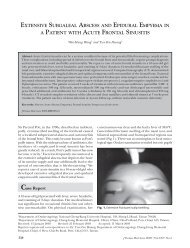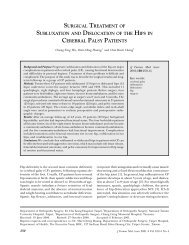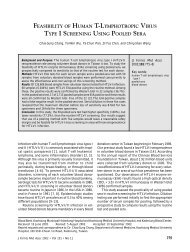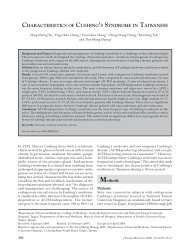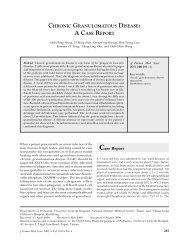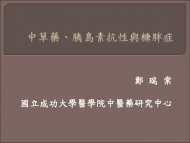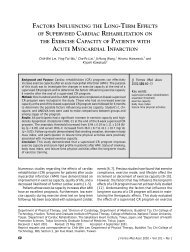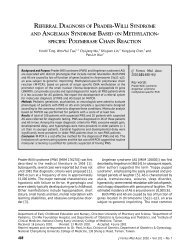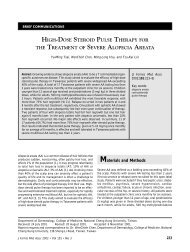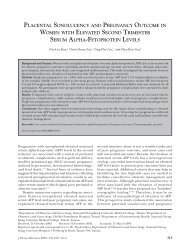pseudocyst formation after intertrochanteric fracture fixation
pseudocyst formation after intertrochanteric fracture fixation
pseudocyst formation after intertrochanteric fracture fixation
Create successful ePaper yourself
Turn your PDF publications into a flip-book with our unique Google optimized e-Paper software.
Pseudocyst Complicating Intertrochanteric FractureBRIEF COMMUNICATIONPSEUDOCYST FORMATION AFTERINTERTROCHANTERIC FRACTURE FIXATION:A CASE REPORTJiann-Long Jean, Chian-Her Lee, 1 Cheng-Mien Chu, 1 Shih-Peng Hsieh, 2 andHsiou-Lan Tang 3Abstract: We describe a 62-year-old woman who developed two <strong>pseudocyst</strong>s, 25 x 15cm and 20 x 12 cm, in the left proximal thigh as a complication 19 years <strong>after</strong> internal<strong>fixation</strong> of an <strong>intertrochanteric</strong> <strong>fracture</strong>. She received a 135° dynamic hip screw andside plate in May 1979. She continued to live at home without major discomfortuntil May 1997. Two huge <strong>pseudocyst</strong>s were noted in the left proximal thigh withouttrauma history. Angiography was normal. Computerized tomography scan revealedtwo voluminous cystic lesions without septa in the left proximal thigh, with accumulatedfluid. During surgery, two huge cysts were found in the left proximal thigh,and their orifices were found slightly proximal to the curvature of the side plate.The pathology showed that the cysts consisted of a nonepithelialized wall of granulationtissue compatible with a <strong>pseudocyst</strong>. The patient had no further problems2 years <strong>after</strong> surgery. We found no reports in the literature of this rare complication.The development of the <strong>pseudocyst</strong>s may have been the result of chronic low-gradetrauma due to irritation between the soft tissue and the implant. Orthopedic surgeonsshould be aware of the possible development of this rare complication followinginternal <strong>fixation</strong> of an <strong>intertrochanteric</strong> <strong>fracture</strong>.(J Formos Med Assoc2001;100:285–8)Key words:<strong>pseudocyst</strong>internal <strong>fixation</strong><strong>intertrochanteric</strong> <strong>fracture</strong>complicationIntertrochanteric <strong>fracture</strong>s involving the femur are commonin elderly patients, and internal <strong>fixation</strong> for this injury isusually performed. The most common complications resultingfrom internal <strong>fixation</strong> of <strong>intertrochanteric</strong> <strong>fracture</strong>s includenail penetration, plate separation, and bending ormechanical failure of the device [1–5]. There have beensporadic reports of pseudoaneurysm or vascular injury following<strong>intertrochanteric</strong> <strong>fracture</strong>s, and the initial symptomsoften include swelling or a protruding mass on the proximalthigh or hip [6–11]. Here, we describe a rare case in whichtwo huge <strong>pseudocyst</strong>s developed long <strong>after</strong> internal <strong>fixation</strong>of an <strong>intertrochanteric</strong> <strong>fracture</strong> of the femur. We found noreports of this complication in a search of the literature.Case ReportA 62-year-old woman fell at home in May 1979, sustaining an<strong>intertrochanteric</strong> <strong>fracture</strong> of the left femur. She was admittedto a local hospital for treatment. Two days later, a 135°dynamic hip screw and side plate were used to internally fixthe <strong>fracture</strong>. Five months <strong>after</strong> surgery she could walk withoutany aids. She continued to live at home without majordiscomfort until May 1997, when she began to feel a protrudingmass over her left proximal thigh. The swelling was firstnoted about 6 weeks prior to her first visit for medical help andDepartments of Orthopedic Surgery and 2 Pathology, Pingtung Christian Hospital, Pingtung City, 1 Department of OrthopedicSurgery, Tri-Service General Hospital, National Defense Medical Center, Taipei, and 3 Mei-Ho Institute of Technology, Pingtung.Received: 1 September 2000. Revised: 28 September 2000. Accepted: 12 December 2000.Reprint requests and correspondence to: Dr. Chian-Her Lee, Department of Orthopedic Surgery, Tri-Service General Hospital,325, Section 2, Cheng-Kung Road, Taipei, Taiwan.J Formos Med Assoc 2001 • Vol 100 • No 4 285
J.L. Jean, G.H. Lee, C.M. Chu, et alhad gradually increased in size since then. She also reportedleft hip pain during ambulation, and restricted left hip mobility.She visited a local medical clinic, where a biopsy wasattempted but was unsuccessful due to massive blood clotextravasation at the biopsy site. The wound was immediatelysutured and the patient was referred to our hospital on thesame day. She had not taken any anticoagulant medication.Physical examination revealed an elderly (81-year-old),alert, obese woman in no apparent distress. A 25 x 10-cmmass was noted over the left proximal thigh, predominantlyover the antero- and posterolateral aspect, as well as tendernessof the left groin and proximal thigh and buttock, andlimited ability to externally rotate her left hip. Her left femoralpopliteal and dorsalis pedialis pulses were equal on bothsides. No bruit was heard on auscultation of the mass, and nodeficits in sensory or motor function were elicited. Radiographsof the left hip showed good union of the previous left<strong>intertrochanteric</strong> <strong>fracture</strong> with retention of the dynamic hipscrew and side plate. Marked soft tissue swelling of theproximal thigh was also noted (Fig. 1). Laboratory findingsincluded a hematocrit of 38%, and blood cell count, calcium,phosphate, alkaline phosphatase, and C-reactive proteinconcentrations, and erythrocyte sedimentation rate withinnormal limits. Computerized tomography (CT) scan of her lefthip and proximal thigh revealed two voluminous cysticlesions without septa in the left proximal thigh, with accumulatedfluid (Fig. 2). Angiography was performed, but noFig. 2. Computerized tomography scan through the left proximalthigh. The difference in size between the left and right thigh is obvious.Two huge <strong>pseudocyst</strong>s lie antero- and posterolaterally within theproximal thigh (arrow).abnormalities of the superficial or deep profunda branches ofthe femoral artery were found, and no pseudoaneurysm wasseen. In July 1997, the mass was explored through the old scaron her left proximal thigh. Upon incision, approximately 1 Lof blood clot was released from the cysts. There were twohuge cysts, 25 x 15 cm and 20 x 12 cm, in the left proximalthigh, predominantly within the antero- and posterolateralregion (Fig. 3 A), and their orifices were found slightlyproximal to the curvature of the side plate (Fig. 3 B). Theimplant was removed and the cysts excised (Fig. 4). Bacterialcultures of the excised cysts were negative. The cysts consistedof a nonepithelialized wall of granulation tissue (Fig. 5).Tissue histology was compatible with that of a <strong>pseudocyst</strong>.Two weeks later, the patient was ambulatory without the aidof a walker and with relief of pain. The follow-up period <strong>after</strong>the operation was 2 years, at which time the patient had nofurther problems and was completely relieved from anydiscomfort.DiscussionFig. 1. Radiographs taken 19 years <strong>after</strong> internal <strong>fixation</strong> demonstrategood healing of the <strong>fracture</strong> and good positioning of the 135°dynamic hip screw. Marked soft tissue swelling is also noted within theproximal left thigh.286In the present case, two huge <strong>pseudocyst</strong>s developed 19 years<strong>after</strong> internal <strong>fixation</strong> of an <strong>intertrochanteric</strong> <strong>fracture</strong>. Nosimilar reported complications were found in a literaturesearch of the MEDLINE ® database.When unexplained thigh swelling is encountered <strong>after</strong>dynamic (compression) hip screw <strong>fixation</strong> of an <strong>intertrochanteric</strong><strong>fracture</strong> or other procedures involving the proximalJ Formos Med Assoc 2001 • Vol 100 • No 4
Pseudocyst Complicating Intertrochanteric FractureAFig. 4. The implants and <strong>pseudocyst</strong>s <strong>after</strong> removal.BFig. 3. A) Two huge <strong>pseudocyst</strong>s of the left proximal thigh. B) Afterincision of the <strong>pseudocyst</strong>, the orifice of the <strong>pseudocyst</strong> is foundadjacent to the curve in the side plate.[12–14]. The <strong>formation</strong> of <strong>pseudocyst</strong>s is mainly observed onthe lateral thigh, hip, buttock, and back, where large muscularsurfaces are present. Under excessive stress, the fat compartmentsmay burst open, with rupture of the septa andshearing of the anchorage of the skin and the superficial fascia[12, 13]. This may result in the development of a cavity intowhich migration of fat, lymph fluid, and blood from theinterrupted lymph and blood capillaries continuously drain,resulting in stasis and encapsulation by fibrous connective orgranulation tissue, and the subsequent <strong>formation</strong> of a<strong>pseudocyst</strong>. In our elderly patient, the <strong>pseudocyst</strong>s may havebeen caused by trivial trauma such as sliding or a contusioninjury. The finding of copious old clotted blood in the two<strong>pseudocyst</strong>s during surgery suggests incomplete liquefactionof a hematoma.Given operative findings suggesting that the psuedocysts’orifices were close to the angle in the side plate, it is likely thatfemur and shaft, the possibility of injury to either the deep orsuperficial branches of the femoral artery must be consideredfirst [6–11]. Previously reported late complications occurringanywhere between 6 weeks and 10 years <strong>after</strong> arterial injuriesduring surgery for <strong>intertrochanteric</strong> <strong>fracture</strong>s include falseaneurysms, arteriovenous fistula, and ischemia of the legdistal to the injured vessel [7, 10, 11]. Injuries at this site havebeen reported to result from the use of drills, and the placementof long screws and retractors too deeply behind thefemur causing compression levering of the artery againstbone [6, 8]. Bone fragments can also cause similar injuries[9].Although the exact mechanism of <strong>pseudocyst</strong> <strong>formation</strong>remains unknown, these lesions are typically the result oftraumatic insults [12]. Although there have been a few rarereports of acute events, chronic minor trauma, possiblyunknown to the patient, is most commonly associated with<strong>pseudocyst</strong> occurrence [13, 14]. The hematoma and the<strong>pseudocyst</strong> may represent opposite ends of a continuum ofdamage and repair of traumatic insults. Development of a<strong>pseudocyst</strong> could be the outcome of chronic, trivial traumaFig. 5. Photomicrographs of the <strong>pseudocyst</strong>s. The sections showpictures of granulation tissue, dense fibrosis, old hemorrhage withinthe wall, and no lining epithelium. This tissue histology is compatiblewith a <strong>pseudocyst</strong> (hematoxylin and eosin, x 20).J Formos Med Assoc 2001 • Vol 100 • No 4 287
J.L. Jean, G.H. Lee, C.M. Chu, et althe <strong>pseudocyst</strong>s resulted from the irritation between the softtissue and the implant due to chronic, trivial injury. Thiscomplication of an <strong>intertrochanteric</strong> <strong>fracture</strong> is apparentlyquite rare, despite the high incidence of these <strong>fracture</strong>s.References1. Kyle RF, Gustilo RB, Premer RF: Analysis of six hundred andtwenty two <strong>intertrochanteric</strong> <strong>fracture</strong>s. J Bone Joint Surg Am1979;61:216–21.2. Bergqvist D, Erikson U: False aneurysm in the deep femoralartery as a complication of osteosynthesis of <strong>intertrochanteric</strong>femoral <strong>fracture</strong>. Acta Chir Scand 1972;138:630–2.3. Laros GS: Intertrochanteric <strong>fracture</strong>s: the role of complications of<strong>fixation</strong>. Arch Surg 1975;110:37–40.4. Chang JH, Wang SJ, Jean JL, et al: Avascular necrosis of thefemoral head following <strong>intertrochanteric</strong> <strong>fracture</strong>: a report of twocases. Formos J Surg 1998;31:380–4.5. Baixauli EJ, Baixauli F, Lozano JA: Avascular necrosis of thefemoral head <strong>after</strong> <strong>intertrochanteric</strong> <strong>fracture</strong>s. J Orthop Trauma1999;13:134–7.6. Karkos CD, Hughes R, Prasad V, et al: Thigh compartmentsyndrome as a result of a false aneurysm of the profundafemoralis artery complicating <strong>fixation</strong> of an <strong>intertrochanteric</strong><strong>fracture</strong>. J Trauma 1999;47:393–5.7. Wolfgang GL, Barnes WY, Hendricks GL: False aneurysm of theprofunda femoris artery resulting from nail-plate <strong>fixation</strong> of<strong>intertrochanteric</strong> <strong>fracture</strong>: a case report and review of the literature.Clin Orthop 1974;100:143–50.8. Storm RK, Sing KA, Graaf EJ, et al: Iatrogenic arterial traumaassociated with hip <strong>fracture</strong> treatment. J Trauma 2000;48:957–9.9. Soballe K, Christensen F: Laceration of the superficial femoralartery by an <strong>intertrochanteric</strong> <strong>fracture</strong> fragment: a case report.J Bone Joint Surg (Am) 1987;69:781–3.10. Keel JD, Eyres KS: Vascular injury by an <strong>intertrochanteric</strong> <strong>fracture</strong>fragment. Injury 1993;24:350–2.11. Hanna GB, Holdsworth RJ, McCollum PT: Profunda femorisartery pseudoaneurysm following orthopaedic procedures.Injury 1994;25:477–9.12. Meggit BF, Wilson JN: The battered buttock syndrome —fat <strong>fracture</strong>s: a report on a group of traumatic lipomata. Br J Surg1972;59:165–9.13. Lacotte B, Demey A, Coessens B: Trauma of the fatty tissue. ActaChir Belg 1994;94:17–20.14. Zecha PJ, Missotten FEM: Pseudocyst <strong>formation</strong> <strong>after</strong>abdominoplasty-extravasations of Morel-Lavallee. Br J Plast Surg1999;52:500–2.288J Formos Med Assoc 2001 • Vol 100 • No 4



